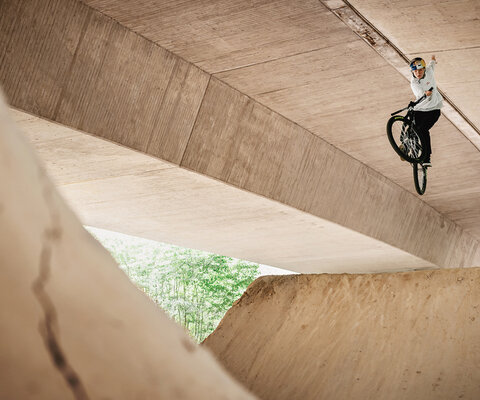
The Stakes Are High Trail Etiquette
Words by Brice Minnigh | Photos by Victor Brousseaud
Words by Brice Minnigh / Illustration by Victor Brousseaud
Each year, mountain bikers are spending more time in the air than ever before.
The advent of the modern flow trail, with its manicured, machine-sculpted perfection, has catapulted us into a new era of high-speed progression. Advanced trailbuilding techniques allow for berms that border on wallrides, ricocheting us from one banked turn to another like they’re the flippers of a pinball machine. Our understanding of jumps has evolved to a space where science meets art, resulting in tables and transitions that squeeze every ounce of speed from what gravity offers—often without the need to pedal.
At the same time, quantum leaps in bike geometry and suspension technology have changed the way many of us read terrain. Obstacles are now opportunities, with rocks, roots and even the slightest bumps on a trail serving as launchpads to airborne freedom. Clever preloading of our suspension is sling-shotting us farther and higher, and a new generation of riders is, arguably, milking as much time in the air as it is on the ground.
All these factors have made the average ride much more predictable and, in many respects, much safer. But with our overall increase in velocity—and our tendency to hurtle through space more often—the consequences can be greater when things go wrong. And with more people mountain biking than ever before, many progressive trails have become congested with punters of staggeringly different skill levels and experience, often making your fellow rider the biggest potential threat to your own safety.
Probably the single-most-fundamental rule in mountain biking is to always keep yourself and your bike on the side of a trail when stopped. Many of us have been guilty of lingering in the middle of a trail while eating a snack or chatting with friends, and many of us have learned this is a bad idea after being mowed down by another unsuspecting rider. I can’t count the number of times I’ve rocketed out of a corner to see a handful of mid-track loiterers, forcing me to careen off trail for an up-close inspection of the local geology.
This stay-off-the-trail edict is especially important on jump lines where speeds tend to be fast and visibility of landings is limited. I have several friends who have sustained seriously debilitating injuries due to midair collisions with people who were standing or sitting in the transition zone. In these accidents, the damage has usually gone both ways, and it has almost always been grave. Jump trails should be treated like freeways—don’t play in them and always look before you run across.
Knowing one’s limits and progressing incrementally are also essential when building the skills to charge advanced lines. Most bike parks have beginner and intermediate jump trails designed to help riders get comfortable with the basics before tackling more challenging runs. Though it can be tempting to follow more experienced friends down black or double-black trails, this can quickly become catastrophic—a fact to which many a bike-park medic can attest. The clinic near the Whistler Mountain Bike Park has treated thousands of injured riders who decided to send it on A-Line when they could have been cruising hotlaps on Crank It Up. Those blue or green trail signs are beacons of learning and the flowy goodness they signal should be viewed as a gateway to a lifetime of safe and happy flying.
On crowded downhill tracks, the need for faster riders to pass slower ones is inevitable and, when done responsibly, will help to keep traffic flow moving steadily. The generally accepted rule is to pass on the left and a friendly shout of “on your left” always helps to alert those you’re overtaking. At the same time, slower riders should keep to the right-hand side of a trail when they hear someone coming in hot behind them, giving ample room to pass and allowing others to carry on at their desired speed. Let’s face it, everyone’s just out to have fun, and a bit of give-and-take goes a long way toward keeping things festive.
Proper maintenance of progressive trails is imperative in keeping them safe, and it’s up to everyone who rides them to play a part. Attending established trail-maintenance events is the most helpful way to do this as it ensures the work being done is necessary and approved by sanctioned trail stewards. It also means safety in numbers as more people give greater visibility to oncoming riders, and “construction in progress” signs or similar markers can be placed higher up the trail to warn others that work is underway. If you’re buffing out your favorite trail by yourself or with a small crew, it’s a wise idea to wear brightly colored clothing in addition to flagging the trail above you.
If you spot a hazard such as a stomach-impaling branch or a downed tree while riding, stop to move it off to the side, or at least set up a warning marker if the object is too heavy to move by yourself. And remember to text your friends about dangerous conditions and trail damage, or, better yet, post a notice on your local advocacy group’s message board to help get the word out quickly. We mountain bikers are part of a giant, ever-growing family, and as we continue our flight path toward bigger jumps, increased trail use and greater speed, we must all chip in to provide a bit of air-traffic control.
For more on Trail Etiquette check out the other stories in the series.
For more on Trail Etiquette check out the other stories in the series.
For more on Trail Etiquette check out the other stories in the series.





